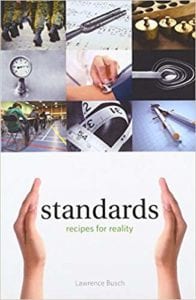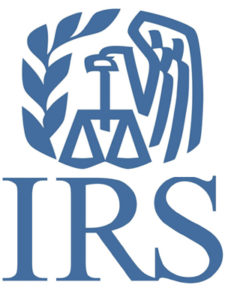 Lawrence Busch’s Standards: Recipes for Reality covers the subject of standards in considerably more complexity than was really necessary for our purposes: developing a section on standards for appraisal review classes. As early as the introduction we found what the class needed, but by then I was already captivated by his premise that standards shape our world in ways we don’t even notice, that standards are so pervasive that most of us are generally blind to how they shape our daily lives, direct and support most of our actions, from taking a walk, buying groceries or even reading an internet post, and, as Busch takes care to point out, create a atmosphere of subtle and not so subtle judgement and ranking. It’s a thought provoking study, in the best sense, and I recommend it to anyone who’s interested in a fresh perspective on how our sense of reality is constructed.
Lawrence Busch’s Standards: Recipes for Reality covers the subject of standards in considerably more complexity than was really necessary for our purposes: developing a section on standards for appraisal review classes. As early as the introduction we found what the class needed, but by then I was already captivated by his premise that standards shape our world in ways we don’t even notice, that standards are so pervasive that most of us are generally blind to how they shape our daily lives, direct and support most of our actions, from taking a walk, buying groceries or even reading an internet post, and, as Busch takes care to point out, create a atmosphere of subtle and not so subtle judgement and ranking. It’s a thought provoking study, in the best sense, and I recommend it to anyone who’s interested in a fresh perspective on how our sense of reality is constructed.
Busch also provides fascinating historical and factual information, some of which leads to interesting considerations about appraisal professional standards. So much to think about just from Chapter 1, The Power of Standards. So I also recommend it to anyone involved in the appraisal profession whether as appraisers, clients, or appraisal support staff, like me.
The Purpose of Standards
In the introduction, Busch begins by laying out the purpose of standards:
As the title of this book suggests, standards are means by which we construct realities. They are a means of partially ordering people and things so as to produce outcomes desired by someone. (p13)
In the case of USPAP, whose desired outcomes are being produced? We might immediately think that the desires of the appraisal profession drive practice standards and in one way that seems obvious. But USPAP was created by Congressional decree in the wake of a financial disaster to address the concerns of lenders and other financial institutions. From that perspective, USPAP addresses the desires of the intended users, who need valuation results that are objective, well-researched and defensible. The other outcome of appraisal standards is to support the public’s trust in the appraisal profession, a clearly stated desire of the appraisal profession, and also an important factor in many financial markets.
Degrees of Tolerance
Yet another meaning of standards, and one closely related to the notion of average or normal, can be found in the notion of tolerance. … tolerances are the maximum acceptable degree to which a thing or object may differ from some specified behavior without incurring some kind of negative sanction. (p25)
Degrees of tolerance make me think of appraisal review. During review, an appraisal is analyzed to gauge its alignment with the standard of care quantified in USPAP — or other appraisal standards, such as IVS (International Valuation Standards). The degree to which the report under review aligns with those standards determines its credibility. A report doesn’t have to be perfect to be creditable. Even machine parts manufactured for extremely exact specifications have a narrow range of tolerances within which the part is still viable. So, too, an appraisal or valuation might present with a number of imperfections and still meet the required credibility standards of accuracy, reasonableness, relevance, adequacy & completeness. What’s important is to stay within acceptable tolerances to avoid sanctions such as your appraisal being rejected in litigation proceedings or even having your accredited or credentialed status revoked.
Commensurability of Appraisal Standards
One last idea I’d like to touch on is that of commensurability. On p34, Busch offers the examples of temperature measurement, where the formula F=9/5+32 calculates the commensurability of Celsius and Fahrenheit; money, which is made commensurate through the standards of currently exchange; and electrical current, which in some cases would be completely incommensurate without the use of specialized transformers and adapters.
So what about appraisal standards? While most US appraisers follow USPAP standards, other appraisers may follow different standards such as International Valuation Standards. ASA’s appraisal review classes discuss how these different standards compare and contrast. Are they fully commensurate, partially commensurate, or completely incommensurate, in the manner of American television standards (NTSC) and French television standards (PAL), the examples Busch cites on p35? Or does it even matter?
However, commensurability of standards is important only when people and things come in contact with one another. (p38)
The most common way for appraisal or valuation standards to come into contact with one another would probably be an appraisal review situation, when a reviewer who works under one standard accepts an assignment to review an appraisal created under different standards. Or when an appraiser who generally operates under USPAP is required to produce an IVS-compliant appraisal.
Earlier this year, ASA offered the webinar Simple Keys to Bridging Standards, offering ways to bridge the similarities and differences between USPAP and IVS, including steps to make a USPAP valuation compliant with IVS. The Appraisal Foundation’s publication addressing the two standards states that “the two standards are already quite similar,” leading me to wonder if perhaps the standards might be judged “partially commensurable” – a term Busch uses when comparing meat butchered in the US and the UK:
Meat butchered according to British standards includes only some cuts that are similar to those produced by an American butcher; many cuts commonly available in the United States are simply unavailable in Britain, and vice versa. (p35)
Similarly, the Appraisal Foundation’s A Bridge from USPAP to IVS reports on what is not covered in the guide:
This guide does not discuss issues in which IVS and USPAP have effectively the same requirements, nor does it cover issues in which USPAP has an additional requirement.
This guide does not discuss any topics that the IVS covers but are not currently addressed by USPAP.
Standards and Appraisal Review
Jack Young‘s recent presentation on Appraisal Review to the CalCPA FSS Joint Section Meeting pointed out that reviewers can use USPAP Standard 3 & 4, which governs appraisal review, to review appraisal reports written under any standard: IVS, USPAP, California State Board of Equalization, IRS, etc. This works because of what Busch refers to as “filters” standards–one of the 4 types of standards discussed early in the book.
The metaphor of the filter suggests the key aspect of this type of standard: some people or things can pass through the filter and thereby meet the standard, while others fail in this regard. (p35)
In the case of appraisal reports, the “filters” of appraisal review are those that USPAP lists to ensure credibility: “the completeness, accuracy, adequacy, relevance and reasonableness of the analysis in the work under review, given law, regulations, or intended user requirements applicable to the work under review.”
Just so you know, Busch’s other types of standards are Olympics, Ranks and Divisions. You might have your own ideas about how those types relate to the appraisal profession. In the meantime, I’m on to Chapter 2, Standardizing the World, which opens with a quote from Charles Babbage that particularly speaks to my world of equipment and machinery appraisal:
“Nothing is more remarkable, and yet less unexpected, than the perfect identity of things manufactured by the same tool.”
Jo Crescent
Operations Manager
NorCal Valuation Inc.


